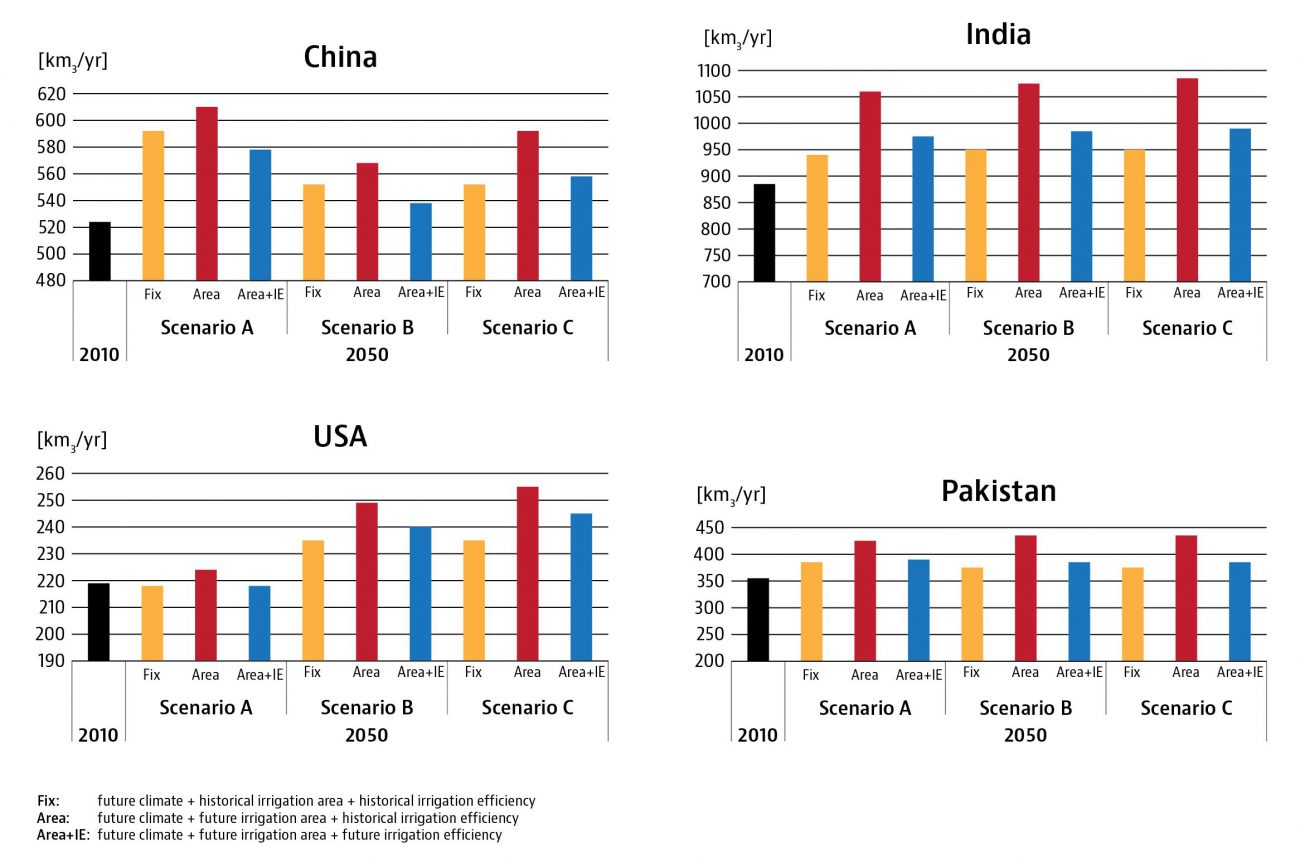Improving efficiency to meet agricultural water demand
Increased water-use efficiency in irrigation systems can cancel out the impact of the expected expansion of irrigation, new IIASA research has shown. The area of crops under irrigation is expected to rise in the coming decades; however, if irrigation efficiency is improved sufficiently net water demand need not increase.
Water security is under threat worldwide and effective, long-term water management strategies are urgently needed. The IIASA Water Future and Solutions Initiative aims to establish a comprehensive water assessment framework which covers agricultural, industrial, and domestic sectors [1]. In a recent study for the initiative, researchers projected the future trajectories of the key drivers of agricultural water demand: crop and irrigation area, and irrigation efficiency.
As a basis for the modeling the authors used three Shared Socioeconomic Pathways, which describe possible paths human societies could follow over the next century, along with the Representative Concentration Pathways, which are greenhouse gas concentration trajectories. Together, these pathways are used as the foundation for much of the world’s global change modeling.
As food demand rises, crop area and irrigation area are both expected to expand, causing an increase in agricultural water demand. The IIASA Global Agro-ecological Zones system (GAEZ) provides projections of the spatial patterns that crop and irrigation areas will follow [2]. These projections take into account different climate scenarios; demographic and socioeconomic factors; production; consumption; and world food trade.
Although water demand is rising, economic and technological progress has the potential to improve water use efficiency. For this work researchers examined irrigation efficiency at a country level, considering all possible combinations of five crop types and three irrigation systems (gravity, sprinkler, and drip irrigation).
Efficiency increases when an existing irrigation system is replaced with an improved irrigation system of the same type, or another higher efficiency system, or when new areas are fitted with a high efficiency system. For this study, therefore, irrigation efficiency was defined as a function of replacement speed and irrigation area, and the researchers assumed that irrigation efficiency would increase with socioeconomic growth.
The GAEZ results indicate that the global area of irrigated land will be 10-15% larger by 2050. Under the sustainability scenario the area of land under irrigation would peak and decline after 2050, but the irrigated area is expected to keep expanding in the other two socioeconomic scenarios (Figure 1).
Irrigation efficiency is expected to steadily improve in all countries because of their economic growth. The biggest improvements were in China (0.6-1.5% efficiency gains per year), India (1.8-2.8% per year), Pakistan (2-3.4% per year), and the USA (0.6-1.7% per year). The results demonstrate that increased irrigation efficiency can cancel out the impact of irrigation area expansion on water demand (Figure 2).
Figure 1. Projections of irrigation area expansion. (a) Projections for each scenarios. Sustainability scenario follows SSP1 (blue), Middle of the Road scenario follows SSP2 (yellow) and Regional Rivalry scenario follows SSP3 (Red).
Figure 2. Change in irrigation water demand (in cubic kilometres) comparing 2010 and 2050 under three scenarios (Scenario A: socioeconomic pathway 1 with representative concentration pathway 4.5. Scenario B: socioeconomic pathway 2 with representative concentration pathway 6.0. Scenario C: socioeconomic pathway 3 with representative concentration pathway 6.0). Yellow bars consider only impact of climate change without irrigation area expansion or irrigation efficiency improvement. Red bars include impact of irrigation area expansion as well as climate change but without irrigation efficiency improvement. Blue bars take irrigation efficiency improvement into consideration as well as the other two impacts.
References
[1] Wada Y, Flörke M, Hanasaki N, Eisner S, Fischer G, Tramberend S, Satoh Y, van Vliet M, et al. (2016). Modeling global water use for the 21st century: Water Futures and Solutions (WFaS) initiative and its approaches. Geoscientific Model Development 9: 175-222.
[2] Fischer G, Tubiello FN, van Velthuizen HT, & Wiberg D (2007). Climate change impacts on irrigation water requirements: Effects of mitigation, 1990-2080. Technological Forecasting and Social Change 74 (7): 1083-1107.
Collaborators
- Martina Flörke, Center for Environmental Systems Research, University of Kassel, Germany
- Stephanie Eisner, Norwegian Institute of Bioeconomy Research, Norway
- Schneider Christof, Center for Environmental Systems Research, University of Kassel, Germany
- Naota Hanasaki, National Institute for Environmental Studies, Japan


